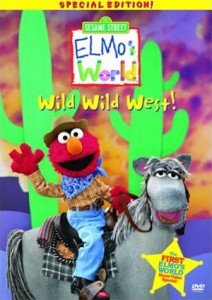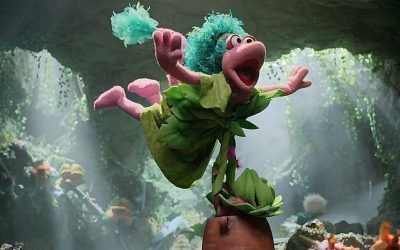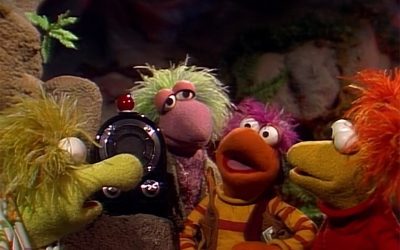Part 1 Part 2 Part 3 Part 4 Part 5
 So let me take a step back at this point and try to define our current Pop Culture Problem.
So let me take a step back at this point and try to define our current Pop Culture Problem.
In the 90’s, it finally sunk in for everybody that the Reagan-era “Young Republican – Morning in America – Just Say No – Ketchup is a Vegetable – Very Special Episode of Family Ties” thing was all a horrible lie, that it was a fake smiley face pasted over some really deep-rooted selfishness.
So in response to that, we spent a while doing post-modern ironic parodies. A lot of self-referential fourth-wall-breaking spoofs. A lot of “air quotes.” Jerry Seinfeld, Garry Shandling, Weekly World News kind of stuff. You may have bought a Bart Simpson T-shirt during this period.
Then after a while, we got tired of that, so then we moved into the post-postmodern, post-ironic phase. In this phase, which is where we are right now, it’s not enough for something to be so bad that it’s good. It has to go further than that, and be so bad that it’s bad, where everything has to be really gross, or depressing, or offensive, or just flat-out dull. This is the John Kricfalusi, Tim Burton, goth-girl, nipple-piercing phase of pop culture. It’s kind of a defensive posture, like people are afraid that other people will make fun of them for being pretentious and self-important, so they self-consciously make themselves ugly to short-circuit any possible mockery.
As far as kid culture goes, this gets expressed in cartoons like Ren and Stimpy, or the Powerpuff Girls, or Spongebob Squarepants — just really, really bad shows, where the whole point is that it’s not funny and that it doesn’t make any sense. These shows are the multiple eyebrow piercings of children’s television. And the problem, of course, is that they’re just hideous and joyless and empty.
But once you’ve been ironic, and then post-ironic, then what’s next? Is it possible to be post-post-ironic without the whole enterprise just collapsing under its own weight?
So here’s where we get back to Elmo, because I think one possible model for how to get out of the irony trap is to go in the direction of Deep Sincerity. Forget about all the defensive “so bad it’s good” post-modern posturing, and find something that you actually believe is really, honestly good.
Which brings us to the new Elmo’s World : Wild Wild West video. There’s not a single air-quotes post-modern moment in the whole thing. Elmo wants to learn about the Wild Wild West, because the Wild Wild West is just really straight-up interesting.
For an example of how Deep Sincerity works, take Mr. Noodle, and Mr. Noodle’s brother, Mr. Noodle. The Noodles are really, really funny — not because they’re a reference to something else, and not because they’re so stupid that they’re funny. They’re funny because they’re played by Bill Irwin and Michael Jeter, who are amazingly talented physical comedians, and they’re cheerful and vulnerable and sweet, and they’re sitting on a cactus and making funny faces. It’s just pure, basic comedy — and if the idea of Bill Irwin sitting on a cactus and making faces doesn’t strike you as funny, then you just need to stop watching The Simpsons for a while until you can pull yourself together.
Here’s another example. Elmo rides a pony in this video — a real, actual live pony. This happens outside, on a real outdoor location. There’s a close-up where he mounts the pony, and then there’s a long shot where you can see Elmo, full figure, riding the pony, trying to catch up to the people riding in a group in front of him. Elmo’s having a great time, laughing and chuckling, because riding a pony is fun. And it’s not fun in the cynical Magic-Cookbook way that washing your hands was “fun.” Riding a pony is Really, Truly Fun. Bonus points for earnestness: Elmo’s pony is named Cinnamon. And at the end of the video, there’s a credit: “Special Thanks: Cinnamon.” Now that is a textbook case of Deep Sincerity. It’s just not possible to be cynical about that.
Now, just because we’re doing Deep Sincerity doesn’t mean that we need to do one of those conservative Return to Traditional Reagan Era Values deals. No no. Just check out Elmo’s introduction of a film clip about a kid riding a horse: “Elmo’s friend Maria — who lives out west in the Navajo Nation — She has her own horse, Strawberry! And she told Elmo all about it!”
You heard that right. Maria lives out west in the Navajo Nation. I mean, how Maya Angelou is that?
So this is why I love Elmo — especially Elmo in his natural habitat, which is Elmo’s World. I’ll admit that we don’t need Elmo shoehorned into romantic dramas like CinderElmo, and we don’t need him pretending that washing his hands is fun in dreary Magic Cookbooks. But in Elmo’s World, he’s engaging kids, and teaching them critical thinking skills — research skills, how do we find out more skills — through the medium of riding ponies and calling people “buckaroo.” Not only is that a deeply, profoundly, sincerely Good Thing To Do, but it’s also fun to watch. Giddyap, Cinnamon.
Part 1 Part 2 Part 3 Part 4 Part 5
by Danny Horn



